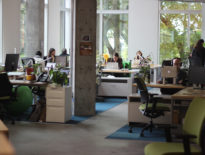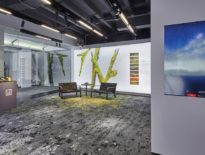Favianna Rodriguez and the Power of the Artist
“Our imagination has the ability to go far beyond the limits imposed by inequality, in order to visualize a truth much bigger than our gender, our race, and our place of origin.”

Originally commissioned by the 2014 People’s Climate March, Favianna created this piece to represent a woman of color and her child at the frontlines of the fight against the climate crisis
She does that through her provocative art pieces, community organizing, and political empowerment programs. She often speaks about how art is an integral part of culture change and how artists can help to shift paradigms. The world needs a dramatic paradigm shift in order to act against climate change and reconcile human’s relationship with nature. What is required of us is to come together as a human species to solve and reimagine the way we live. Art is a powerful platform for this and allows people to push past what they believe is possible.
In the following interview, Favianna shares the power of art and how it is can play a critical role in supporting positive change. She explores how art can be a storytelling platform, a place of empowerment, a bridge to social justice and environmentalism, and much more.
Joanna Gangi: How can artists create a new narrative for change, specifically related to the fight against climate change?
Favianna Rodriguez: Art is about how we see the world, whether it’s a painting, film, or other things, it is a reaction to our human condition. Throughout history, the relationship between art and society is such that it helps people to innovate.
Artists help us imagine how things can look different and they can help tell a story of the future. They create some of the things that we as human beings most attach to like music and books. They create such compelling narratives for a society and civilization, and if we know that to be true, then artists cannot go unorganized, nor can they go unresourced. What I mean by unorganized is that, when we’re dealing with significant human challenges such as racial and gender inequality, and climate change, we need to understand that artists are solutions in that space and artists can help us address how we challenge those kinds of very engraved problems.
Problems are often a consequence of habit and of systemic ways of working. Artists can disrupt those habits or those systemic ways by showing complexity and by actually shining a light on what’s really happening, which helps people change focus. Artists introduce complexity and stories that help us be empathetic to each other as human beings and to the planet.
Artists can expose ways that are emotionally based and can help tap into what kind of world we do want to build.
JG: There are three components to social change—culture, politics, and economics. You say that cultural change proceeds political and economic change. Why is culture an essential component to this?
FR: Denis Hayes’ creating Earth Day is such a critical example of why culture matters. Earth Day is a cultural practice that’s kind of like a holiday. It’s a cultural tradition that was building, which led to a lot of great things.
The culture around marriage equality helped drive political change. There were television shows about the issue, there were sports icons speaking up about it, there were authors and many more people building the momentum. Together they composed a lane of culture that happened faster than the politics and it moved people differently. So, by the time of the Supreme Court victory in 2015, the cultural space had already been activated many years before.
For the climate change movement, there are a lot of white artists in the space, but where is the hip-hop sector or Latin music sector? It’s not happening—and even though climate change impacts disproportionately affect communities of color, their stories are not being told. The issues around climate change are seen as less important than issues around violence or incarceration that many communities of color are facing. But, in reality, these are all urgent things and are all connected.
We need musicians, filmmakers, and visual artists—people really embedded in communities that are affected by climate change to tell another story about it. We need another organized group of people that is advancing a different kind of story and a different kind of narrative.
JG: Your work through CultureStrike does a beautiful job of showcasing the many different faces of the environmental movement. Why is it important to show the many faces and diversity of environmentalism?
FR: Climate change is a human problem and historically has been caused by humans that have had more power. Colonial forces built an entire society based on dirty energy and some of the consequences of that are being seen in migration. Migration is happening because years ago the colonial powers ravaged the natural resources and the ecosystems of those countries where people could no longer sustain themselves.
For example, up and down the Central Valley in California where a quarter of the food is grown for this country, there are people with respiratory diseases, there are people who are exposed to pesticides, and many of these communities are communities of color. It is a similar scenario in Texas with the location of oil refineries and communities of color.
Unless we hear the stories of those affected, then we have less ability to feel empathy but also to understand the impact of how the system works because climate change and environmental degradation can only happen if people are not seeing the impacts.
What we can’t see prevents us from having a well-rounded analysis of the problem. If we’re seeing a very homogeneous story about climate and the environment, we’re not seeing the full story. For human beings to make informed decisions and find solutions to climate change we need to tap into our empathy and our connection to each other, and know that if one community is suffering we are all suffering.
JG: How can the environmental movement be more inclusive and diverse?
FR: I think awareness is changing. I think it’s changing very fast because the very compelling examples like Standing Rock or Flint, Michigan, where the movements are being led by communities of color. So I believe we are in the midst of a shift.
And the way the movement can be more inclusive is first to take a moment to really educate on and understand how climate injustices are playing out in your local community and elsewhere. Having an understanding of that can help you connect with some of the organizations that are working on their behalf and helping to tell the story.
Also, inviting communities and leaders of color to the table and investing in their leadership will help break the silos and encourage an intersectional approach.
JG: Can you describe how the intersectionality of the sustainability movement and the social justice movement are important?
FR: We have to be able to connect the dots. Many social justice issues are related to an extractive system and many environmental issues are related to extractive systems. And these systems impact human beings. The prison system is extractive. The agriculture industry is extractive. Extractive systems don’t work. It doesn’t work whether you’re extracting from a mountaintop or whether you’re extracting from communities. We need to think beyond that. We need to imagine another kind of like coexistence so we understand we’re interdependent.
JG: Your art represents a very powerful message. What message do you have for young people who may be struggling to find their voice but also know that they want to make a positive difference?
FR: Be an artist and be creative. Create new stories and messages that really speak to your heart and be bold in imagining a future. Tell us and show us what that future looks like.




